By Kelly Ann Young, Physical Therapy Assistant
What is yoga? Yoga is an ancient practice of exercise, breathing, and meditation dating back over 5000 years with roots in India. Despite its existence for thousands of years, it wasn’t until the last few decades that it has become very popular in mainstream Western society. Its popularity has risen because of its great benefits which include, but are not limited to, stress relief, pain relief, relaxation, and muscle stretching (flexibility). Other advantages include strengthening of muscles, reduction of anxiety, metabolism boost, and improved digestion. (Course Workbook)
While yoga is a comprehensive practice, we will look at a few of the specific breathing techniques that can be useful in our physical therapy practice.
Pranayama: (Breath Control)
Certain exercises called “pranayama” (also known as breath control) can increase blood oxygenation, produce calming effects, or produce energizing effects. Benefits include cleansing of the lungs, improved digestion, improved cardiovascular system endurance helping to stabilize heart rate and blood pressure, and improved ability to focus on a task. (Course Workbook) For people with certain medical conditions, it may not be safe to perform certain breathing exercises. A health care professional or yoga instructor should be consulted prior to performing.
How do we breathe if we want to warm up our bodies, energize them, and lose that sluggish feeling?
- Kapalabhati (bellows breath) – Take a few normal breaths. Inhale through your nose and forcefully exhale through your nose with four quick bursts of air. Repeat four times.
- Ujjayi (victorious breath) – Place the tip of your tongue on the roof of the mouth behind the teeth. Contract throat “open” as if yawning. Inhale and exhale through your nose.
How do we breathe if we want to warm up our bodies and calm them down at the same time?
- Humming Bee Breath – Inhale through your nose, exhale making a steady humming sound.
How do we breathe if we want to cool our bodies down and calm them down at the same time?
- Sithali (the cooling breath) – Roll your tongue and place beyond your bottom lip. Inhale through the groove of your tongue. Close your mouth and hold your breath for a few seconds. Exhale through your nose.
- Sitkari (the sucking breath) – Place the tongue on the roof of the mouth just behind your front teeth. Inhale through your mouth. Close your mouth and hold the breath for a few seconds. Exhale through your nose.
References:
Course Workbook – Therapeutic Yoga: Bridging Ancient Practices with Traditional Therapy Techniques
www.americanyogaassociation.org





